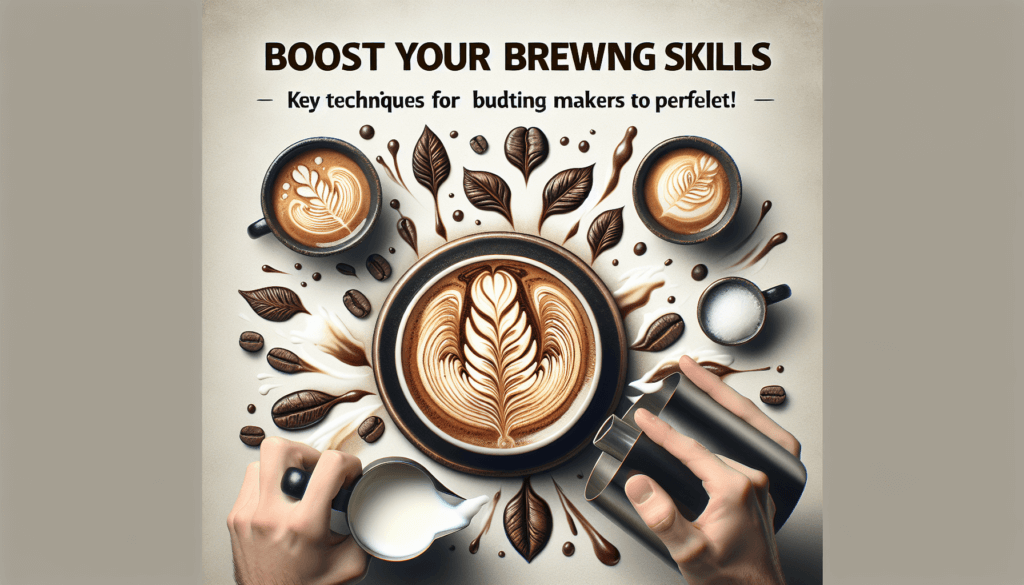Are you dreaming of becoming a skilled barista? Well, look no further! In this article, we will explore the key skills that every aspiring barista should master. From perfecting the art of brewing the finest coffee to creating beautiful latte art, we will guide you on your journey to becoming a coffee connoisseur. So grab a cup of your favorite brew and let’s get started!
Knowledge of Coffee Beans
Understanding different types of coffee beans
As an aspiring barista, it’s important to have a solid understanding of the different types of coffee beans that are used to make your beloved beverage. Coffee beans are generally categorized into two main types: Arabica and Robusta.
Arabica beans are known for their higher quality and more nuanced flavors. They are usually grown at higher altitudes and have a smoother and sweeter taste. On the other hand, Robusta beans are more robust and have a stronger, sometimes even bitter, flavor. They are often used in espresso blends for their higher caffeine content and to provide a fuller body to the coffee.
Knowing the differences between these two types of coffee beans will enable you to make informed recommendations to your customers and serve them the perfect cup of coffee tailored to their preferences.
Knowing the origin and processing methods of coffee beans
In addition to being aware of the different types of coffee beans, it’s also essential to understand the origin and processing methods of these beans. Coffee is grown in various regions around the world, and each region has its own unique flavor characteristics.
For example, beans from Latin America are known for their bright acidity and fruity notes, while those from Africa often have floral and citrusy flavors. Understanding these flavor profiles will help you guide your customers in selecting the coffee that suits their taste preferences.
Moreover, familiarizing yourself with the various processing methods, such as washed, natural, and honey processes, will allow you to explain the characteristics and nuances of different coffees to your customers. This knowledge will not only enhance your credibility as a barista but also help you provide a more personalized coffee experience.
Identifying the flavor profiles of various coffee beans
One of the key skills every barista should possess is the ability to identify the flavor profiles of different coffee beans. This involves developing your sensory perception and training your palate to discern the various tastes and aromas present in coffee.
Through cupping sessions and frequent tasting, you can begin to recognize the unique flavor notes that certain coffee beans possess. For example, you may detect caramel, chocolate, or berry-like flavors in specific coffees. This knowledge will enable you to guide your customers in selecting beans that align with their preferred flavor profiles, ensuring they have an exceptional coffee experience every time they visit.
Grind and Brew Techniques
Exploring different grind sizes for various coffee beverages
When it comes to brewing coffee, the grind size plays a crucial role in extracting the perfect flavors from the beans. Different brewing methods require different grind sizes, so it’s important to familiarize yourself with their nuances.
For example, a coarser grind is typically used for pour-over methods, as it allows for a slower extraction and a cleaner cup of coffee. On the other hand, finer grinds are used for espresso, as the increased surface area allows for a faster extraction and the creation of the characteristic espresso crema.
By mastering the art of grinding coffee beans to the appropriate size for each brewing method, you can ensure that the flavors are extracted optimally, resulting in a delicious cup of coffee every time.
Understanding the importance of water temperature and extraction time
Alongside grind size, water temperature and extraction time are critical factors that impact the final flavor of the coffee. The ideal water temperature for brewing coffee is between 195 to 205°F (90 to 96°C). Water that is too hot can over-extract the coffee, resulting in a bitter taste, while water that is too cool may result in under-extraction, leading to weak or sour flavors.
Similarly, the extraction time must be carefully controlled to achieve the desired flavors. Over-extraction can result in a bitter-tasting coffee, while under-extraction can produce a weak and watery brew. Understanding these variables and their impact on the coffee’s taste will enable you to adjust your brewing techniques accordingly and consistently produce high-quality cups of coffee.
Mastering the use of espresso machines and other brewing equipment
As a barista, you’ll likely work with various brewing equipment, including espresso machines, pour-over devices, and French presses. It’s essential to develop a thorough understanding of how each equipment functions and how to operate them correctly.
Mastering the use of espresso machines, for instance, involves understanding the different components, such as the grinder, portafilter, and steam wand, and knowing how to adjust them to achieve the desired espresso shot. Additionally, learning the proper techniques for assembling and using other brewing equipment will ensure that your coffee is brewed consistently and to the highest standard.
Familiarizing yourself with the necessary steps and techniques for brewing a variety of beverages will not only showcase your expertise but also allow you to provide a diverse range of coffee options to your customers.

Milk Frothing and Latte Art
Achieving the perfect milk texture for different drinks
Milk is a key component in many popular coffee beverages, such as cappuccinos, lattes, and macchiatos. To master the art of milk frothing, you must learn how to achieve the perfect texture for each drink.
For a cappuccino, you’ll want to create a thick and velvety foam with small bubbles, which can be achieved by introducing air into the milk during the frothing process. On the other hand, a latte requires a smoother and silkier texture, achieved by steaming the milk to create a microfoam.
By practicing and refining your milk frothing techniques, you’ll be able to create well-textured milk for each beverage, enhancing the overall taste and presentation of the coffee.
Learning various milk frothing techniques
Milk frothing involves a combination of proper technique and attention to detail. There are different methods to achieve the desired milk texture, such as the swirling method, the rolling technique, and the wiggle method.
The swirling method involves swirling the steaming pitcher in a circular motion to create a whirlpool effect, which helps to distribute the foam evenly throughout the milk. The rolling technique requires rocking the pitcher back and forth to create a smooth and consistent texture. Lastly, the wiggle method involves moving the steam wand up and down while simultaneously swirling the pitcher to create a creamy and well-incorporated foam.
By practicing and experimenting with these techniques, you’ll be able to perfect your milk frothing skills and consistently create beautifully textured milk for your customers’ favorite drinks.
Practicing latte art designs and pouring techniques
Latte art is the creative and aesthetically pleasing aspect of being a barista. It involves using the milk foam as a canvas to create intricate designs and patterns on the surface of the coffee.
To become proficient in latte art, start by mastering the basic designs, such as the heart, tulip, and rosetta. Learn the proper pouring techniques and practice drawing these designs on a fresh shot of espresso. With time and practice, you’ll be able to create more complex and elaborate designs, impressing your customers with your artistic skills.
Remember, latte art not only adds visual appeal to the coffee but also demonstrates your attention to detail and commitment to providing a memorable coffee experience.
Customer Service and Communication
Developing excellent interpersonal skills to engage with customers
The role of a barista extends beyond coffee preparation; it also involves providing excellent customer service. Developing strong interpersonal skills is essential for engaging with customers and ensuring they have a positive experience at your café.
Being friendly, approachable, and attentive are crucial qualities in creating a welcoming atmosphere for customers. Greet each customer with a smile, engage in small talk, and demonstrate genuine interest in their coffee preferences. Building positive relationships with your customers will not only encourage them to return but also enhance their overall experience.
Understanding customer preferences and providing personalized recommendations
As a barista, you’ll often encounter customers with different tastes and preferences. To ensure customer satisfaction, it’s important to understand and cater to their individual coffee preferences.
By actively listening to your customers and asking open-ended questions, you can gain valuable insights into their preferred flavor profiles, brewing methods, and dietary restrictions. Using this information, you can provide personalized recommendations tailored to their tastes, helping them discover new and enjoyable coffee options.
Remember, happy customers are more likely to become repeat customers, so take the time to understand and meet their unique preferences.
Handling customer complaints and resolving issues effectively
No matter how dedicated you are to providing the best coffee experience, there may be times when customers are dissatisfied or encounter issues. It’s crucial to handle customer complaints and resolve any issues with professionalism and efficiency.
When faced with a complaint, listen attentively to the customer’s concerns, empathize with their situation, and offer a genuine apology if necessary. Take immediate action to rectify the issue, whether it involves remaking the coffee, offering a refund, or providing a suitable alternative.
By addressing customer complaints promptly and effectively, you can turn a potentially negative experience into a positive one, fostering customer loyalty and trust in your establishment.

Time Management and Efficiency
Optimizing workflow in a fast-paced environment
The role of a barista often involves working in a fast-paced environment, especially during peak hours. To excel in such conditions, it’s important to optimize your workflow to maximize efficiency and minimize wait times for customers.
Organize your workspace to ensure that essential tools and ingredients are easily accessible. Adopt a systematic approach to coffee preparation, prioritizing tasks based on their brewing time and complexity. This may involve prepping ingredients in advance, ensuring enough coffee is ground and ready for brewing, and maintaining a steady flow of coffee production.
By streamlining your workflow, you’ll be able to serve customers quickly and efficiently, providing them with a positive experience even during busy periods.
Prioritizing tasks and managing multiple orders simultaneously
In a bustling café environment, it’s common to receive multiple orders simultaneously. To handle and serve these orders efficiently, it’s important to develop strong multitasking and prioritization skills.
Assess each order’s complexity and brewing time to determine the appropriate sequence of tasks. Start with brewing methods that require longer extraction times and simultaneously work on simpler tasks, such as frothing milk or preparing other ingredients. By strategically managing your time and prioritizing tasks, you can ensure that all orders are served promptly without compromising the quality of the coffee.
Remember to remain calm and composed, even during busy periods, as this will help you maintain accuracy and quality in your coffee preparation.
Maintaining cleanliness and organization in the workspace
Successful baristas understand the importance of cleanliness and organization in creating a smooth and efficient work environment. A clean and well-organized workspace not only enhances workflow but also contributes to the overall experience for both baristas and customers.
Regularly clean and sanitize your equipment, such as the espresso machine, grinders, and steam wand, to maintain optimal performance and prevent any flavors from transferring between drinks. Keep your work area tidy by promptly organizing and restocking ingredients and tools, ensuring that everything is within easy reach.
By prioritizing cleanliness and organization, you’ll create a visually appealing workspace and avoid any potential disruptions in your coffee preparation process.
Cash Handling and Point of Sale Systems
Understanding cash handling procedures and ensuring accuracy
As a barista, you’ll likely be responsible for handling cash transactions from customers. It’s crucial to understand cash handling procedures and ensure accuracy to maintain the financial integrity of your café.
Familiarize yourself with proper cash counting techniques to expedite transactions and minimize errors. Learn how to identify counterfeit bills by paying attention to security features, such as watermarks and security threads. Maintain a secure cash drawer and ensure that the correct change is given to customers, double-checking calculations as necessary.
By demonstrating proficiency in cash handling, you’ll instill trust in your customers and maintain a transparent and efficient transaction process.
Using point of sale (POS) systems for order management and payment processing
Modern cafes utilize point of sale (POS) systems to streamline order management and payment processing. It’s important for baristas to be familiar with these systems and understand their functionality.
Learn how to navigate the POS system and input orders accurately. Familiarize yourself with the various functions, such as modifying orders, processing payments, and generating receipts. Ensure that you are familiar with any additional features specific to your café, such as loyalty programs or integration with mobile apps for ordering and payment.
By mastering the use of POS systems, you can expedite the ordering process, minimize errors, and provide a seamless experience for both customers and colleagues.
Managing transactions and providing correct change to customers
One of the essential skills for a barista is efficiently managing transactions and providing accurate change to customers. This involves being proficient in mental math and maintaining attention to detail.
When processing payments, swiftly calculate the total amount due, including any applicable taxes or discounts. Use proper coins and bills to provide the correct change, double-checking to ensure accuracy. Maintain a friendly and helpful demeanor throughout the transaction and thank the customer for their patronage.
By handling transactions smoothly and accurately, you’ll create a positive impression on your customers, ensuring a pleasant and hassle-free experience.

Menu Knowledge and Product Upselling
Memorizing the coffee menu and ingredients of various beverages
A comprehensive knowledge of your café’s coffee menu is essential for providing efficient service and accurate recommendations to your customers. Take the time to memorize the menu, including the names of each drink and their ingredients.
Understanding the specific components of each beverage will allow you to answer any customer queries and provide detailed descriptions. This knowledge also enables you to make appropriate modifications based on customer preferences or dietary restrictions.
By showcasing your expertise in the menu, you’ll instill confidence in your customers, guiding them toward their perfect cup of coffee.
Learning about seasonal promotions and special offerings
In addition to the standard coffee menu, many cafés offer seasonal promotions and special offerings to entice customers and celebrate certain occasions. As a barista, it’s important to stay updated on these promotions and be able to communicate them effectively to your customers.
Familiarize yourself with the details of each promotion, including any limited-time drinks or discounts. Understand the key selling points and highlight the unique features of these offerings when engaging with your customers. Encourage them to try new flavors or take advantage of special deals, enhancing their overall coffee experience.
By being knowledgeable about seasonal promotions and special offerings, you’ll not only increase customer engagement but also contribute to the café’s overall success.
Suggesting additional products or upgrades to enhance the customer experience
Upselling is an essential skill for baristas, as it allows you to offer additional products or upgrades to enhance the customer experience and increase sales. By understanding your customers’ preferences and needs, you can make targeted recommendations that align with their interests.
For example, if a customer orders a regular drip coffee, you can suggest adding a flavored syrup or an extra shot of espresso to elevate the taste. If they mention a preference for a specific flavor profile, you can recommend a different coffee blend that matches their preferences.
By providing thoughtful and personalized recommendations, you’ll not only enhance the customer’s coffee experience but also promote loyalty and potentially increase revenue for your café.
Consistency and Quality Control
Maintaining consistent flavor and presentation of beverages
Consistency is key in the world of coffee, as customers often return to their favorite cafes for the reliability of their beverages. As a barista, it’s important to maintain consistent flavor and presentation of your coffees to meet and exceed customer expectations.
Following standardized recipes and brewing techniques is crucial in achieving consistency. Use precise measurements for coffee, water, and milk, and ensure that each step, from grinding the beans to steaming the milk, is executed consistently. Pay attention to details such as water temperature, extraction time, and milk frothing techniques to ensure that each cup of coffee meets the quality standards set by your café.
By delivering consistent flavor and presentation, you’ll build trust with your customers, ensuring their loyalty and satisfaction.
Following standard recipes and brewing techniques
Every café has its own set of standard recipes and brewing techniques to ensure the consistent quality of their coffee offerings. As a barista, it’s crucial to adhere to these recipes and techniques to maintain the desired taste and presentation.
Become familiar with the specific measurements of coffee, water, and other ingredients for each beverage. Pay attention to the recommended brew ratios, extraction times, and temperatures. Execute each step precisely, whether it’s grinding the beans, tamping the espresso, or timing the extraction.
By following the established recipes and brewing techniques, you’ll not only produce consistent and delicious coffee but also contribute to the overall reputation of your café.
Performing quality control checks to ensure the highest standards
Maintaining high standards of quality is a fundamental aspect of being a barista. Regularly performing quality control checks is essential in ensuring that the coffee you serve meets the highest standards.
Take the time to taste your coffee regularly to ensure that it meets the desired flavor profile and balance. Evaluate the aroma, acidity, body, and finish of each cup. Pay attention to the crema of espresso shots, ensuring that it is the right color and consistency.
Additionally, visually inspect each drink for proper presentation, such as latte art and froth density. Ensure that the temperature is appropriate for each drink and that all necessary garnishes or accompaniments are included.
By conducting regular quality control checks, you’ll identify any inconsistencies or areas for improvement, enabling you to take the necessary steps to maintain the highest standards of coffee excellence.

Cleaning and Maintenance
Regular cleaning of espresso machines, grinders, and other equipment
Proper cleaning and maintenance of your coffee equipment is crucial for maintaining optimal performance, extending their lifespan, and ensuring the quality of your coffee. Regularly clean your espresso machine, coffee grinder, steam wand, and other equipment according to the manufacturer’s instructions and café protocols.
Cleaning the espresso machine involves backflushing, descaling, and wiping down the exterior. The coffee grinder should be cleaned by removing accumulated coffee residue and adjusting grind settings as needed. The steam wand should be purged and wiped clean after each use.
By incorporating regular cleaning into your routine, you’ll prevent flavor transfer between drinks, ensure consistent brewing, and promote a hygienic work environment.
Understanding the importance of descaling and backflushing
Descaling and backflushing are essential tasks in maintaining the cleanliness and performance of your espresso machine. Descaling involves removing mineral deposits that accumulate over time, while backflushing cleans the internal parts, such as the brew head and shower screen, to remove any coffee residue.
Follow the manufacturer’s guidelines for the recommended frequency of descaling and backflushing. Using appropriate cleaning solutions and thoroughly rinsing your equipment after the process will prevent the buildup of impurities that can affect the taste and quality of your coffee.
By staying diligent with descaling and backflushing, you’ll ensure that your espresso machine functions optimally, resulting in consistent and delicious coffee.
Performing routine maintenance tasks to prevent breakdowns
Preventing equipment breakdowns is essential in maintaining workflow and minimizing disruptions in the café. As a barista, it’s important to perform routine maintenance tasks to keep your coffee equipment in prime condition.
Regularly check for any signs of wear and tear or malfunction, such as loose connections, leaks, or unusual noises. Replace worn out or damaged parts as necessary and ensure that all moving components are properly lubricated. Follow your café’s maintenance schedule for routine replacement of filters, gaskets, and other perishable parts.
By being proactive in maintaining your coffee equipment, you’ll prevent unexpected breakdowns, ensure the continuity of your coffee service, and save costs on major repairs or replacements.
Continuous Learning and Adaptability
Keeping up with industry trends and new brewing techniques
The world of coffee is constantly evolving, with new brewing techniques and industry trends emerging regularly. As a dedicated barista, it’s important to stay informed and adapt to these changes to deliver a cutting-edge coffee experience.
Stay updated with industry publications, coffee blogs, and social media platforms dedicated to coffee. Read about new brewing methods, innovative equipment, and experimental flavor combinations. Attend coffee workshops, training sessions, and industry events to gain practical knowledge and learn from industry experts.
By continually expanding your knowledge and embracing new brewing techniques, you’ll stay ahead of the curve, offer innovative coffee experiences, and maintain your passion for the craft.
Attending coffee workshops and training sessions
Attending coffee workshops and training sessions is an excellent way to deepen your understanding of coffee, refine your skills, and connect with other professionals in the industry. These educational opportunities offer hands-on experience, insight into the latest brewing techniques, and a chance to exchange knowledge and ideas with fellow baristas.
Look for workshops and training sessions offered by coffee associations, specialty coffee shops, or equipment manufacturers. Topics may include latte art, espresso tasting, advanced pour-over methods, or coffee bean sourcing.
By actively seeking out educational opportunities, you’ll continuously enhance your skills, broaden your perspective, and develop a strong network among coffee professionals.
Adapting to changes in customer preferences and seasonal demands
Customer preferences and seasonal demands can have a significant impact on the coffee industry. As a barista, it’s important to be adaptable and responsive to these changes to meet the evolving needs of your customers.
Pay attention to customer feedback, trends, and shifts in taste preferences. Assess the demand for certain seasonal drinks or ingredients and adjust your offerings accordingly. Experiment with new flavors, specialty coffees, or alternative brewing methods to offer unique experiences to your customers.
By embracing flexibility and adapting your coffee offerings to changing customer preferences and seasonal demands, you’ll ensure that your café remains relevant and continues to attract loyal customers.
In conclusion, being a barista requires more than just making a cup of coffee. Developing essential skills in coffee knowledge, brewing techniques, milk frothing, customer service, time management, cash handling, menu knowledge, and quality control will allow you to excel in this role. Continually learning, adapting, and striving for excellence will ensure that you can provide an exceptional coffee experience and make a lasting impression on your customers. So embrace these skills and enjoy the journey of becoming a masterful barista.



